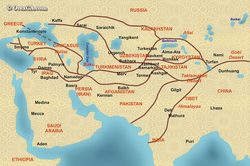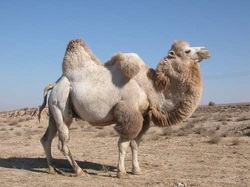GoRome
The Silk Road
Kaleigh Riggs
6G-1
The Silk Road was a very important system of trade that spread ideas and knowledge that led humanity to this point in time. Many empires such as the Roman Empire, the Parthian Empire, the Kushan Empire, the Han Empire, and the nomadic confederation of Xionanu were a big influence on the Silk Road. The Silk Road wasn't really just one road, it was a network of smaller roads and waterways (rivers and seas). Strategically located trading posts enabled exchange and storage of goods that the Silk Road with the opportunity of flourishing for a very long extent of time.
Christianity was one and ideology that spread quickly throughout the Silk Road. This along with Buddhism were typically the main religions that spread through the Silk Road. If you visit ancient Rome through GoRome, you can experience how it spread, where it spread, and hen it spread. If you are one of those people that doesn't like listening to somebody else talk, go to ancient Rome through GoRome and be the teacher, not the student. Even today, Christianity is still spreading in Asia at a rapid rate. Don't you want to know how the people spread the thought of Christianity. They didn't just call somebody on their iPhone 4 and say, "I want to worship God. You in?" NO! You could be lucky enough to actually have someone come up to you and tell you about Christianity and how it spread. Christianity is one very important characteristic of the Silk Roads.
Another important lesson to learn is that YOU NEED A CARAVAN TO DO DESERT EXPLORATION! Caravans are what a few merchants (traders) would travel in. Caravans weren't as luxurious as BMWs and Porsches, but they were better than walking through the desert on your bare feet. OUCH! Caravans are people and their goods on some sort of pack animal (notably the reliable Bactrian camel). You don't have to walk and you will get a nice tan while you are riding a camel. The travelers of the Silk Roads started traveling in caravans because of the bandits in Silk Roads territory. The bandits started hearing all of these rumors about people traveling their way with expensive goods. The bandits finally went in for the kill. Merchants would arrive to their destination with barely anything because they would trade with people on their way, or the bandits would steal it all. Caravans were a very important part of traveling safely throughout the routes of the Silk Roads.
Another important lesson to learn is that YOU NEED A CARAVAN TO DO DESERT EXPLORATION! Caravans are what a few merchants (traders) would travel in. Caravans weren't as luxurious as BMWs and Porsches, but they were better than walking through the desert on your bare feet. OUCH! Caravans are people and their goods on some sort of pack animal (notably the reliable Bactrian camel). You don't have to walk and you will get a nice tan while you are riding a camel. The travelers of the Silk Roads started traveling in caravans because of the bandits in Silk Roads territory. The bandits started hearing all of these rumors about people traveling their way with expensive goods. The bandits finally went in for the kill. Merchants would arrive to their destination with barely anything because they would trade with people on their way, or the bandits would steal it all. Caravans were a very important part of traveling safely throughout the routes of the Silk Roads.
Are you one of those sale rack shoppers? Well, you would love traveling on the Silk Roads. In ancient times, sale racks weren't called sale racks, they were called merchant bales. You could find things such as elephant tusks, tortoise-shells, rhino horns, and many other things that make fantastic souvenirs. Merchants make a living by trading things to people on the other side of the continent. They go through agonizing thirst and hunger to sell and barter things. And, they also go on their journey knowing that there's a chance that nomads, bandits, and rebels might "jump" them. Blinding storms are another precaution. Are you a fabulous cook? Do you run out of spices all of the time? Well this won't happen any more! You can find exotic spices that you've probably never heard of in merchant bales. Isn't this great?
Many things beside silk were traded on the Silk Roads. Gold, ivory, and exotic plants and animals were also popular on the Silk Roads. Out of everything though, silk was perhaps the most remarkable for people to the West. Don't you want some of these works of ancient art? They don't make them like this in the modern world. No we have fancy machines that can do the dirty work for us. You should visit the Silk Roads because you can buy something for the price of cheap dirt and then sell it when you get back to the modern world. The people that live there can give you first hand education on what everything is instead of reading an article that could be fake. And lastly, you get to meet the merchants. These merchants can teach you how to really negotiate. Maybe even in a different language.
There were not very many things to look forward to when traveling hundreds of miles across the desert, but something pleasurable was the thought of passing through an oasis. An oasis is a little bit of green grass with refreshing water, usually. Water in the desert? IMPOSTUROUS!!! Well, think again because an oasis does have water that is drinkable. The water that you can find in an oasis is quite refreshing and fabulous for your skin. The Silk Roads have many hidden secrets that you can explore with GoRome. Remember, the grass in greener in an oasis...literally.
Today on the present day Silk Roads, the roads are increasing in importance again. There has been progress in controlling the outrageous sands. The Silk Roads are quickly being industrialized. Trade within the C.I.S. is picking up rapidly with a flourishing trade in consumer items as well as heavy industry. Now, a railway connecting Lanzhou to Urumchi has been extended to the border of Kazakhstan and in 1990 joined the former Soviet railway system. The Silk Roads have now been re-opened, but it's a better and more exciting experience using GoRome as your guide to the Silk Roads in Ancient Rome.
Many things beside silk were traded on the Silk Roads. Gold, ivory, and exotic plants and animals were also popular on the Silk Roads. Out of everything though, silk was perhaps the most remarkable for people to the West. Don't you want some of these works of ancient art? They don't make them like this in the modern world. No we have fancy machines that can do the dirty work for us. You should visit the Silk Roads because you can buy something for the price of cheap dirt and then sell it when you get back to the modern world. The people that live there can give you first hand education on what everything is instead of reading an article that could be fake. And lastly, you get to meet the merchants. These merchants can teach you how to really negotiate. Maybe even in a different language.
There were not very many things to look forward to when traveling hundreds of miles across the desert, but something pleasurable was the thought of passing through an oasis. An oasis is a little bit of green grass with refreshing water, usually. Water in the desert? IMPOSTUROUS!!! Well, think again because an oasis does have water that is drinkable. The water that you can find in an oasis is quite refreshing and fabulous for your skin. The Silk Roads have many hidden secrets that you can explore with GoRome. Remember, the grass in greener in an oasis...literally.
Today on the present day Silk Roads, the roads are increasing in importance again. There has been progress in controlling the outrageous sands. The Silk Roads are quickly being industrialized. Trade within the C.I.S. is picking up rapidly with a flourishing trade in consumer items as well as heavy industry. Now, a railway connecting Lanzhou to Urumchi has been extended to the border of Kazakhstan and in 1990 joined the former Soviet railway system. The Silk Roads have now been re-opened, but it's a better and more exciting experience using GoRome as your guide to the Silk Roads in Ancient Rome.
Bibliography
The Silk Road Map. (online image) Available at: orexca.com May 19, 2011.
Bactrian Camel. (online image) Available at: true-wildlife.blogspot.com May 19, 2011.
"Silk Road." http://www.ess.uci.edu (5-5-11).
" Stream of Life. The Silk Road History." http://www.sairamtour.com (5-5-11)
"Trade Between the Romans and the Empires of Asia." http://depts.washington.edu (5-9-11)
"The Silk Road: A Larger View." http://sites.asiasociety.org (5-9-11)
"East Meets West: The Silk Road (Overview)." World History: Ancient and Medieval Eras. ABC-CLIO, 2011. Web. 5 May 2011.
Research Questions
1. What as traded on the Silk Roads besides silk?
2. What were merchant bales?
3. What is the present day Silk Road like?
4. What were oases used as/What were they?
5. What did the people and goods travel in?
6. What religions spread the most through the Silk Road?
1. What as traded on the Silk Roads besides silk?
2. What were merchant bales?
3. What is the present day Silk Road like?
4. What were oases used as/What were they?
5. What did the people and goods travel in?
6. What religions spread the most through the Silk Road?
Contact Information
Kaleigh Riggs
Silk Road chief expert
Nobel Prize winner
Yale graduate Masters and PhD degree
(123)456-7890
[email protected]


